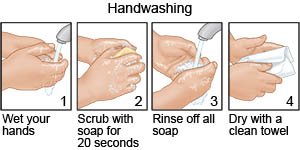Sternal Precautions
Medically reviewed by Drugs.com. Last updated on Aug 4, 2025.
AMBULATORY CARE:
Sternal precautions
are safety guidelines to help protect your sternum (breastbone) after open chest surgery. Wires or plates are placed during surgery to hold the sternum together as it heals. Sternal precautions help prevent injury, pain, infection, and bleeding. The goal is to prevent putting stress on the healing sternum. You may need the precautions for up to 12 weeks after surgery.
Call your local emergency number (911 in the US) if:
- You have sudden pain in your sternum and hear a crunch or pop.
- You have bleeding that does not stop even after you apply pressure for 5 minutes.
Seek care immediately if:
- You hear crunching or grinding in your sternum.
- You have signs of an infection, such as a fever, red or warm skin, or pus in the surgery wound.
Call your doctor if:
- You continue to feel pain, even after you take your pain medicine.
- You have new or worsening pain, or any pain with movement.
- You have questions or concerns about your condition or care.
How to do sternal precautions:
Your healthcare provider will give you specific instructions. It is important to follow the instructions carefully. An injury to the healing sternum can be life-threatening. Your provider may teach you to imagine a tube is around your chest and upper arms. Any movement you make with your upper body or arms will need to stay inside the tube. The following are general sternal precaution guidelines:
- Start slowly and do more as you get stronger. Pain medicine might make it harder for you to know when to slow down or be careful. Stop immediately if you have pain, or if you hear a crunch or pop.
- Protect your sternum. Hug a pillow to your chest or cross your arms over your chest when you laugh, sneeze, or cough.
- Limit arm movements. Use both arms together. Keep your elbows close to your body if you must reach for something. Do not reach far over your head or out to either side of your body. Do not reach your arms behind you. Do not let anyone pull your arms to help you move, dress, or stand.
- Be careful when you get into or out of a chair or bed. Use your legs and momentum to stand. Your provider may teach you to ways to get out of a chair or bed more easily. Do not pull yourself up to a standing position by holding a grab bar or furniture.
- Ask about lifting or carrying objects. Your provider may give you a specific weight limit, such as 5 pounds. With or without a weight limit, use both arms together to lift or carry anything.
- Do not drive while you are healing. Your provider will tell you when it is safe for you to start driving again.
- Follow wheelchair instructions, if needed. Your provider will tell you if it is okay to push the wheels to move yourself around. Keep your elbows in. Use both arms together to push the wheels.
Care for the surgery area:
Always wash your hands before you care for the area. Do not rub the area as you wash or dry it. Pat the area dry with a clean towel. Change the bandages as directed and when they get wet or dirty. Ask when you may take a bath or shower.
 |
Do not smoke:
Nicotine can damage blood vessels and make it more difficult to heal. Do not use e-cigarettes or smokeless tobacco in place of cigarettes or to help you quit. They still contain nicotine. Ask your healthcare provider for information if you currently smoke and need help quitting.
Follow up with your doctor as directed:
Write down your questions so you remember to ask them during your visits.
© Copyright Merative 2025 Information is for End User's use only and may not be sold, redistributed or otherwise used for commercial purposes.
The above information is an educational aid only. It is not intended as medical advice for individual conditions or treatments. Talk to your doctor, nurse or pharmacist before following any medical regimen to see if it is safe and effective for you.
Further information
Always consult your healthcare provider to ensure the information displayed on this page applies to your personal circumstances.
